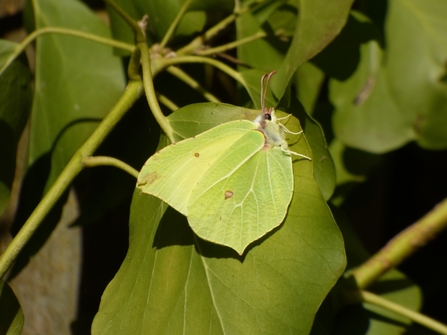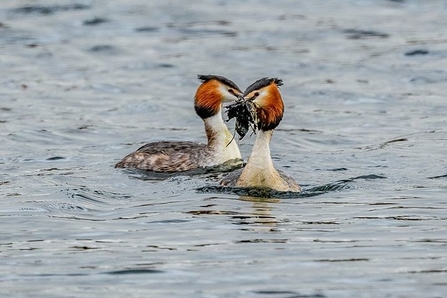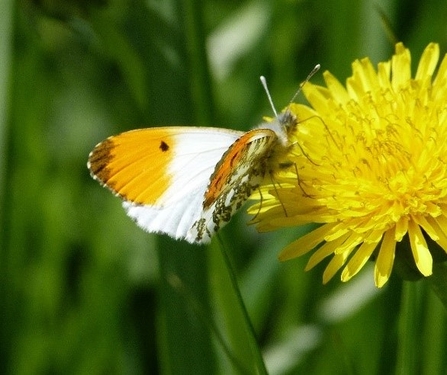On a very mild Valentine’s Day in February (14th), it all began with a sighting of a brimstone, our first butterfly of 2019. This was quickly followed by many more of them in the coming days- mainly bright yellow males seeking a spot to warm themselves and to look for females. The brimstone is our longest-lived butterfly and, if its lucky, its life can span three calendar years and two winter hibernations. Its also thought to the species that gave butterflies their name- it is the original ‘butter-coloured fly’.
Spring has sprung at Lackford
Silver birch catkins at sailing lake by Mike Andrews

Brimstone by Mike Andrews
Three days later, on the 17th, great-crested grebes started to congregate on the Lakes. Right now, they are generally seen in pairs and are in magnificent full breeding plumage- over the past few weeks each bird in the pair have been growing beautiful orange and brown head crests. Their elaborate courtship ritual is lovely to watch too- mutual dancing, head bobbing, diving and exchanging of food items is a real highlight to be seen at the moment- look out for them on the Sailing Lake and on Hawker Pool especially.

Great crested grebes - Angela Lord
February also brought with it the first skylarks seen climbing high in the air and singing (at the same time!) on the 20th. Sayer’s Breck is a good spot for these and you stand a good chance of seeing bullfinch, green woodpecker, mistle thrush and barn owl over here too. Our first comma butterfly was seen on the 22nd, and a red admiral two days later. Back in February they were enjoying early blackthorn blossom but now hawthorn has taken over, with ground ivy and primroses being other popular nectar sources. The 22nd March was also the day our oystercatchers noisily announced their return- the muddy islands viewable from Bernard’s and Steggall’s hides are good places to spot these.
Due to the weather and wind direction being a bit less favourable in late February and early March, we had a bit of a lull in activity until March 9th, when the first chiffchaff was heard. Initially just one or two birds were about but now they are everywhere! It’s almost impossible to take a walk around the Kingfisher trail without hearing several. They are also joined in song now by blackcaps- although we didn’t hear our first one until 29th March, their lovely fluty warble is playing almost constantly in the scrub by Winter hide and in Ash Carr too.
blackcap by Mike Andrews
Now we’re into April, a walk on a sunny day at Lackford could be rewarded with a few other butterflies, as March also saw the emergence of small tortoiseshell and peacock (21st) and a little later orange-tip (30th). Just last Friday (5th April) a green-veined white was seen, and together with the orange tip these species signal that the weather is becoming mild enough, and the days long enough, for species to fly that have emerged directly from a chrysalis this year. Many early butterflies, like peacock, are individuals that have simply awakened from hibernation- all they need is a few hours of warmth to charge themselves up for flight, whereas butterflies that were locked away over winter in a chrysalis need a few days of warmth and calm weather to trigger the final stages of development and then the hatching and drying of their wings. Any day now should see our first speckled wood, small white and holly blue too!

orange-tip by Mike Andrews
An exciting development on the Slough through yesterday and into today (7th April) has been the presence of a small gang of four avocet, wading deep into the water and sifting the water with their delicate bills. Either Paul’s, Bernard’s or Double Decker hide should give you good views of these for as long as they stay, and you may also catch sight of up to two little ringed plover around the muddy edges (first seen on April 4th). These are dwarfed by the avocet, the plovers being little bigger than blackbirds!
avocets by Mike Andrews
So in the coming weeks, keep an eye out for a bigger range of butterflies and also on the sky above you- house martins and the odd swallow have been seen flying high above larger bodies of water- Sailing Lake and Long Reach especially. Spring is a time of change and so its likely every day will be a little different from the last- any day now we might see our first large red damselflies, and plenty of birds such as cuckoo, nightingale, garden warbler, whitethroat and hobby will be on their way to us soon! If you want to find out the latest news when you visit, check in at the Centre at the start of your walk and speak to us or have a look at our sightings book.

